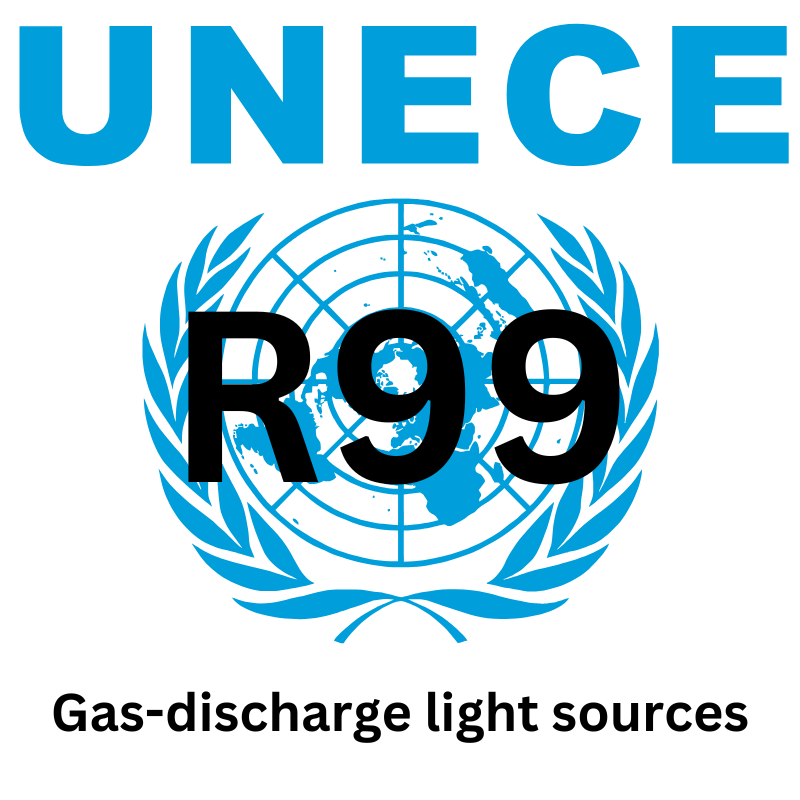Guide To: UNECE R99 - Gas-discharge light sources
31 October 2024

Guide To: UNECE R99 - Gas-discharge light sources
The UNECE Regulation No. 99 governs the standards and specifications for gas-discharge light sources used in vehicles, specifically focusing on their performance, safety, and quality standards. This regulation plays a crucial role in ensuring that these light sources meet stringent requirements for automotive lighting systems, enhancing visibility and safety for drivers and passengers alike.
Scope and Purpose of Regulation No. 99
Regulation No. 99 applies to gas-discharge light sources intended for use in approved lamps of power-driven vehicles. The primary aim is to standardize the design, photometric characteristics, and electrical requirements of these light sources, ensuring they are safe, reliable, and meet global automotive industry standards.
Key Provisions of Regulation No. 99
The regulation outlines various technical and administrative requirements, including:
Approval and Testing: Gas-discharge light sources undergo rigorous testing for characteristics such as luminous flux, colour, and starting and run-up performance. Testing ensures consistency and safety across products from different manufacturers.
Type Approval: The regulation provides a framework for manufacturers to obtain type approval for their products. Approved gas-discharge light sources must bear specific markings to indicate compliance, including the international designation and wattage.
Photometric and Electrical Standards: The regulation specifies technical standards such as the objective luminous flux, starting characteristics, and permissible colour variations. These characteristics help maintain uniformity across gas-discharge light sources, regardless of the manufacturer.
Environmental and Safety Considerations: Given the ultraviolet (UV) output potential of gas-discharge sources, the regulation includes limits on UV radiation to prevent harm to materials and occupants. Additionally, the regulation mandates the use of low UV-emission designs where possible.
Incorporation and Alignment with Other UNECE Regulations
UNECE Regulation No. 99 is part of the larger framework of UNECE vehicle regulations, designed for reciprocal recognition among contracting parties. In 2017, the regulation saw amendments aligning it with Resolution R.E.5, a comprehensive framework for automotive lighting and signalling devices, to streamline standards and eliminate redundancies across multiple UNECE regulations.
These harmonized amendments help Regulation No. 99 integrate with broader vehicle lighting standards, such as UNECE Regulation No. 48, which oversees the installation of lighting and signalling equipment. By aligning Regulation No. 99 with these overarching standards, it ensures that vehicle manufacturers meet consistent safety and technical requirements across different jurisdictions.
Amendments and Updates
Since its initial implementation, Regulation No. 99 has undergone several revisions to keep pace with technological advancements and evolving safety standards. For example, amendments have included updates to luminous flux requirements and specific configurations for light sources like D1S and D2S, enhancing performance and reliability. These changes reflect a commitment to maintaining high standards for vehicle lighting and responding to industry innovation.
Conclusion
UNECE Regulation No. 99 establishes a robust framework for the approval and standardization of gas-discharge light sources used in vehicles, ensuring high performance, safety, and quality. Its alignment with other UNECE regulations supports consistent standards worldwide, providing manufacturers with clear guidelines and promoting safer, more efficient automotive lighting systems.